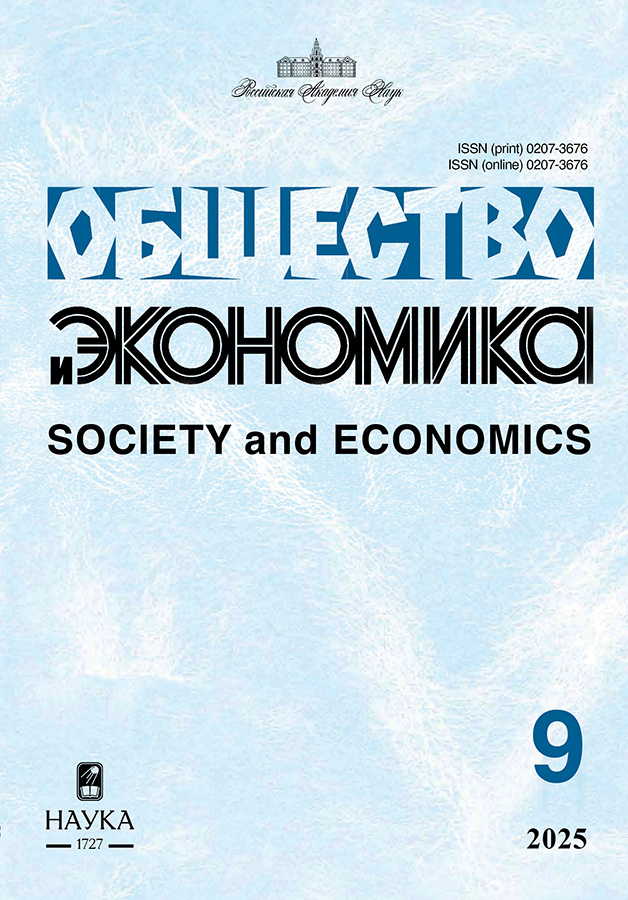№ 12 (2024)
ВОПРОСЫ СОЦИАЛЬНОЙ СФЕРЫ
Восточное и западное направления трудовой иммиграции в Россию: исторические маркеры и перспективы
Аннотация
В работе систематизированы понятия восточного и западного направлений трудовой иммиграции в Россию как терминов для условного обозначения потоков мигрантов из бедных стран СНГ и квалифицированных специалистов из других стран, включая развитые западные страны. Автором дана оценка аналитики ограничения массовой миграции в принимающие страны; представлены оценки оригинальных статистических алгоритмов; отмечены исторические маркеры иммиграции человеческого капитала, опыт которых может быть использован в современной иммиграционной модели; показаны негативные тенденции снижения уровня иностранной рабочей силы и трансформации трудовой иммиграции из стран Центральной Азии в социальную (гражданскую), вместе с рисками, сопутствующими натурализации новых граждан.
 46-64
46-64


ВОПРОСЫ ЭКОНОМИЧЕСКОЙ ПОЛИТИКИ
Глобальный разворот в национальных промышленных стратегиях: курс на технологическую самодостаточность
Аннотация
Статья исследует глобальный феномен секьюритизации промышленной политики в начале 2020-х годов, связанный с синхронным переходом различных стран мира к курсу на достижение технологической самодостаточности/суверенитета в приоритетных секторах (курс на ТС). Рассмотрены причины разворота стран от приоритетов экономической эффективности к доминированию приоритетов экономической безопасности. Выявлены типовые общие черты и национальные особенности курса на ТС в ведущих развитых и развивающихся странах (США, ЕС, Китай, Индия, Бразилия), а также издержки и риски этих стран в достижении его целей. На фоне данного глобального тренда проанализирована специфика российского курса на ТС в условиях санкций, сформулированы объективные ограничения для его успешной реализации на внутреннем и внешнем контуре. Сделан вывод, что тренд на секьюритизацию будет усиливаться, но накопление издержек от геополитической фрагментации мировой экономики со временем вернет страны к прежней экономической открытости.
 5-25
5-25


Технологический суверенитет в отражении патентной статистики: искусственный интеллект и полупроводники
Аннотация
Статья посвящена анализу мировой патентной статистики в области технологий искусственного интеллекта и полупроводников. На основе анализа выявлено, что в период 2019–2023 гг. на четыре ведущие страны в совокупности приходилось порядка 90% мирового объема опубликованных патентных заявок на технологии как в сфере искусственного интеллекта, так и в области полупроводников. Исследование выявило низкую патентную активность России в анализируемом периоде, сопровождающуюся отрицательной динамикой публикации патентных заявок. В качестве одного из возможных решений для стимулирования патентной активности российских заявителей предлагается корректировка научно-технологической и промышленной политики.
 26-33
26-33


Участие бизнеса и некоммерческих организаций в реализации национальных проектов и повестке устойчивого развития (на примере Красноярского края)
Аннотация
Методологическую основу исследования участия региональных субъектов предпринимательства в повестке ESG и реализации национальных проектов составили концепция устойчивого развития и ресурсная теория. По результатам опроса 208 респондентов из 144 организаций частного и государственного секторов экономики Красноярского края, крупные госкомпании существенно отстают от крупных частных компаний по степени участия в реализации нацпроектов и ESG-повестке. Вовлеченность малого и среднего бизнеса и некоммерческих организаций более слабая. Выявлено, что основными препятствиями являются недостаток ресурсов, слабая информированность об инструментах участия и непонимание пользы от участия.
 34-45
34-45


МИРОВАЯ ЭКОНОМИКА
Внешняя торговля России: вызовы и уроки 3 лет санкционного давления
Аннотация
В статье подробно рассматривается этапность санкционного давления на Россию в 2022–2024 гг. и его влияния на российскую экономику, анализируется логика эволюции санкционного режима и специфика применяемых Россией контрмер. Выделены 3 этапа современного санкционного давления, отличающиеся характером и направленностью ограничений. Показано, что современная модификация санкционного режима, реализующаяся с конца 2023 г., характеризуется прогрессирующим нарастанием скорости раскручивания «санкционной спирали», фокусировкой на борьбе с российской стратегией обхода санкций (в том числе, посредством расширения вторичных санкций и мер против российского «теневого» флота) и фактическим возвратом к политике ограничения физических объемов российского экспорта, что обуславливает усиление рисков для развития отечественной экономики и внешней торговли в 2025 г.
 65-79
65-79


Трансформация внешнеторгового взаимодействия России с постсоветскими странами в условиях санкций
Аннотация
В статье исследуются тренды, проблемы и перспективы торговых связей России с постсоветскими государствами в контексте введенных Западом санкционных ограничений. Рассматриваются ключевые предпосылки нейтральности большинства стран СНГ в отношении антироссийских санкций. Анализируется динамика, структура и этапы торгового взаимодействия России с постсоветскими странами за период 2022–2024 гг. Отмечается важность действующих преференциальных торговых соглашений России со странами Евразийского экономического союза (ЕАЭС) и данного объединения с третьими странами в развитии посреднической торговли. Проводится типология стран региона в зависимости от интенсивности и характера их торговых связей с Россией.
 80-91
80-91


Внешнеторговое взаимодействие СГ–ЕАЭС–БРИКС: современные тренды и перспективы
Аннотация
Исследование посвящено анализу торгово-экономического взаимодействия Союзного государства (далее – СГ), ЕАЭС и БРИКС+. Цель работы проанализировать тенденции развития экономического сотрудничества в рамках СГ–ЕАЭС со странами БРИКС+, выявить потенциальные направления развития экспорта России и стран указанных объединений. Для оценки тенденций торгово-экономических отношений в рамках СГ и ЕАЭС используются индексы интенсивности торговли, что позволяет определить наиболее перспективных торговых партнеров среди стран БРИКС+. В ходе исследования также обнаружена необходимость оценки потенциала и перспектив увеличения экспорта стран СГ и ЕАЭС в страны БРИКС+. Для решения этой задачи произведена оценка индекса склонности к экспорту стран СГ и стран ЕАЭС в страны БРИКС+, что позволило выявить пределы и средства для реализации возможных программ сопряжения развития формата СГ, ЕАЭС со странами расширенного формата БРИКС+.
 92-105
92-105
















